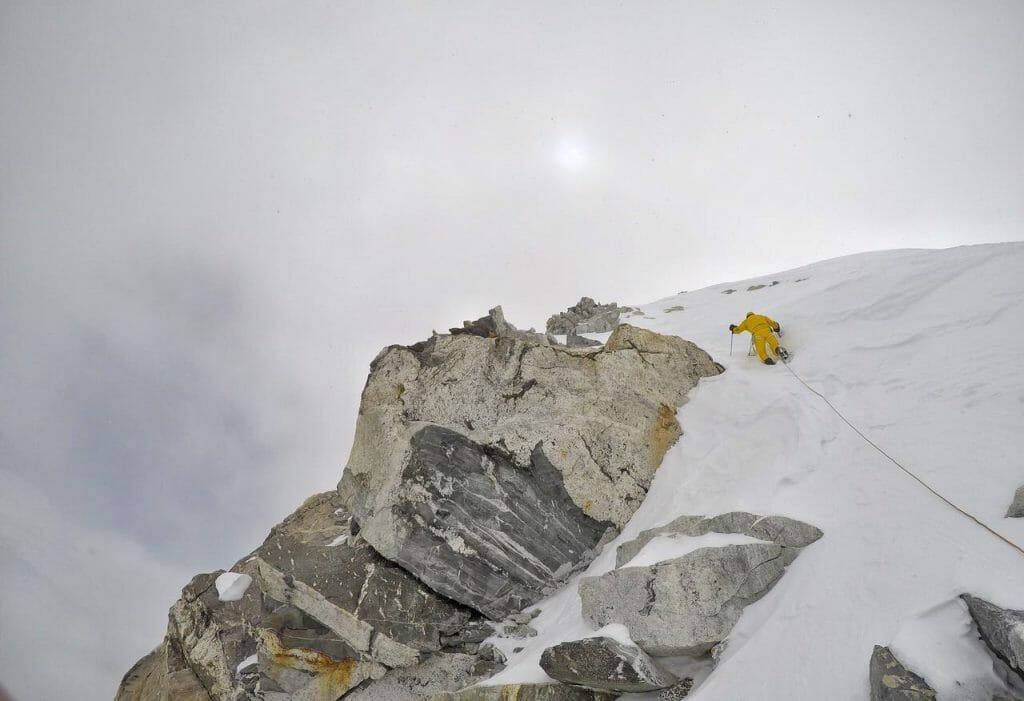The following article was written by professional alpinist David Goettler about his return to the south face of Shishapangma in May 2017 to again attempt a new route that he and Ueli Steck had tried in 2016. Below, David reflects on where his personal journey to these mountains has taken him and makes some interesting observations about how a second year of structured training has brought him to a new level of fitness.
Progress and Success
This year I returned to the south face of Shishapangma. For me to want to return to the same mountain two years in a row with the same goal was unusual in itself; but among other things it brought a perfect opportunity to really see the effects that supervised, focused training can have. It was an opportunity to learn even more about myself: my ability to perform, to grow, to progress, and to adjust to a variety of challenges and conditions. It gave me the chance to witness a maturation in my approach to and performance on 8,000-meter peaks.
Perhaps one of the most important things to address was trying to define what motivates me in the first place. Why do I want to climb these mountains? It’s not an easy sentiment to articulate, but ultimately the reason behind the desire is also what drives me to train, to suffer, to sacrifice, and to risk all that I do for such an abstract trophy as standing on the summit of a mountain.
I don’t want to break any records.
I don’t want to be faster than others before me.
I don’t seek or hope for fame or fortune.
I simply want to be a better version of myself than I was yesterday, or than I was the last time I tried something. I want to evolve and make progress. I want to feel like I am improving with time and effort. Seeing that I can become better at a task gives me enough joy and satisfaction to motivate myself to train harder, suffer a bit more, and enjoy the transformation.
In addition to a physical and psychological improvement, I need to be able to look at my climbs objectively and feel satisfied that I have achieved my goals in a style of which I can be proud. The “purity” or “quality” of climbing styles is something that individual climbers need to define for themselves. There is no right or wrong so long as the essential rules of honesty and respect are adhered to. We need to be entirely honest about how we do things, and we need to be utterly respectful of those with whom we climb and the environment in which we climb. If those two golden rules are respected there is no breach of trust to the climbing community, to the climbing environment, or to anyone interested enough to follow what climbers do. For example, for me the difficulty of climbing 8,000-meter peaks lies primarily in the fact that the availability of oxygen up there is greatly reduced, and because of that, I believe that using oxygen out of a bottle is, in a way, disrespectful of the boundaries that are set by nature itself. But that is another story and we can talk about that another time.
Now, looking back on what I have learned over the past two years of training with Scott and focusing on this singular goal, I have identified a few key things that I know will serve me well in the future.
First and foremost I have learned to concentrate on myself and not on those around me. I am lucky enough to be constantly surrounded by some of the best people in climbing and mountain sports. Kilian Jornet and the late Ueli Steck live, train, and play in the same areas as I do. Kilian represents the pinnacle of mountain endurance athletes and Ueli was unique in his speed, dexterity, and skill in some of the most difficult and exposed terrain in the Alps and elsewhere. Both of these guys have been training for most of their lives.
The best training plan will be individualized. If I had fallen into the trap of wanting to do the same amount of training as they do I could have worked myself into the ground before ever having taken off. I developed the ability to learn from the experts around me but have never let myself try to imitate them. I stuck to what my coach told me and had faith in his experience and knowledge of how to get the best results. Whenever I trained or spent time climbing with Ueli, I still listened to my body and tried hard to stick to the guidelines that Scott and I discussed in advance. I took more rest days in between pushes and I made sure to be ready for our big climbing days by sticking to my own agenda on the days in between. It may sound obvious or logical, but I’m sure that being baited to do too much too soon by friends or colleagues is not an unfamiliar feeling to many of you! So far, by sticking very closely to the training plan that Scott prescribes for me, I have managed to have no periods of illness or loss of motivation due to overtraining. If you look at my graphs, the readings constantly go up at a slow but steady pace, showing the gradual improvement in performance that Scott and I hope for. This result is exactly what makes a coach (and me) very happy!
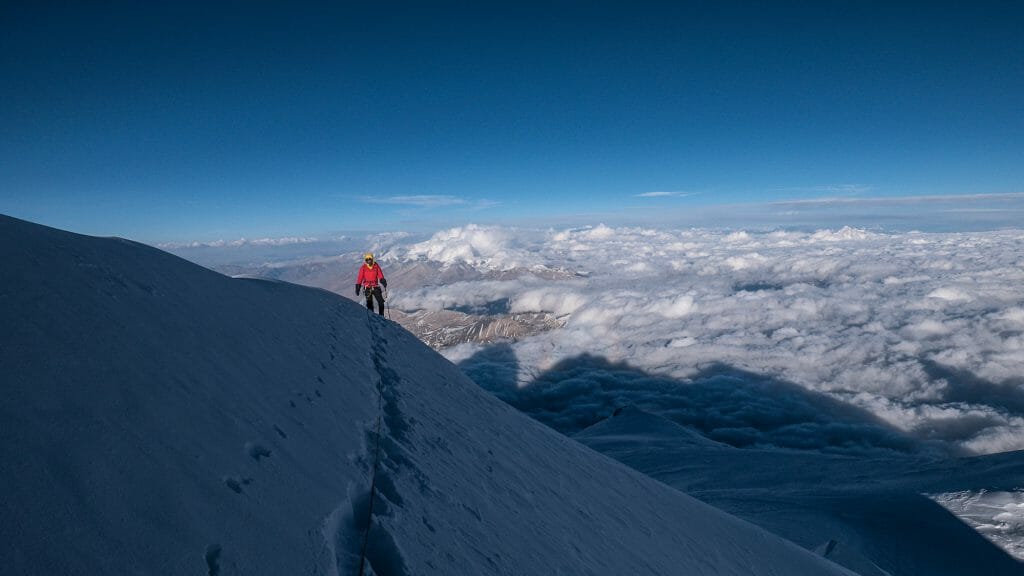
Near the summit of Shishapangma.
The second very logical and self-evident thing that I learned was again one that can be all too quickly forgotten. Following a well-planned training schedule that is structured in such a way that the training style and focus change frequently will lead to less fatigue and greater gains. So much of this (somewhat counterintuitively) hinges on the amount of rest you also need to take. Rest days and recovery days feature in my training schedule as often as hard workouts do. By using this method I managed to make the most dramatic change in my fitness that I had ever accomplished in my life as a professional athlete to date.
Two years ago when Scott and I started with my training, it was about building as wide a base as possible. I’m lucky in that my background as a mountaineer and a mountain guide meant that this step didn’t take me too long. The first period consisted of a lot of low-intensity runs below my Aerobic Threshold. In those early days those were painfully slow and mind-numbingly boring! My motivation was so high at that moment and I had imagined being pushed to my limits, doing some super-gnarly Rocky Balboa–type workouts. Instead, Scott just had me doing long, slow runs.
Thankfully, though, once Scott was happy with my improvement he introduced more spice. We started with hill sprints and mountain endurance workouts, and then, in the run up to my first expedition to Shishapangma in spring 2016, very specific workouts that mimicked my planned climb. This approach brought a massive boost to my level of fitness. Ueli Steck was my climbing partner for that expedition, and after our expedition Ueli wrote an email to Scott to thank him for how much stronger he had made me. If you think that just by paying Scott or Uphill Athlete you will miraculously get fitter, you are sorely mistaken and had better save your money for something else.
Modern technology was key to enabling this process for me: Scott and I were able to monitor and plan every workout even though we live thousands of kilometers away from each other. By using TrainingPeaks as the online tool to make the training agenda, we had a platform onto which I could upload all the data from my watch for Scott to check the information and use it to plan the next bit of training. This, paired with a Skype call every second week or so, meant that I never felt at all alone with a random training schedule. It always felt tailor-made to how I was feeling and what I needed. Scott was able to see, follow, and adjust upcoming workouts based on how I had performed in the workout I had just done.
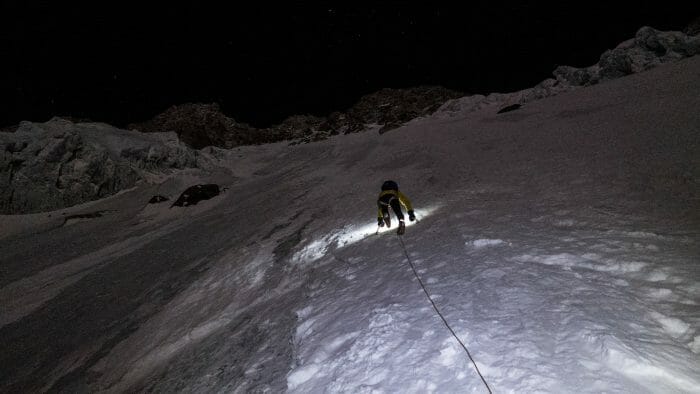
Keeping up with Ueli on Shishapangma in 2016.
A crucial element in making good progress with a new training regime is being fully committed. Recognizing that you need to sacrifice time in your life to do your training is imperative if you want to see positive results. The more time you can manage to make available for training, the better results you will see. There are no shortcuts! Don’t fool yourself into thinking that you can be as fit as Kilian Jornet or Ueli Steck if you only have 5 hours a week to train. Those guys have trained for their entire lives—day after day, year after year. I was also able to put almost all of my time into my new training regime; my chosen profession as a mountain guide and the sponsors I have been lucky enough to gather over the years mean that most of my time is at my disposal to be moving in the mountains either training or working. Not everyone has this freedom so it is important to keep your expectations in line with your commitment.
Bringing this back to the example of my expeditions: the first expedition to Shishapangma, in spring 2016, was where I was able to feel the significant gain in my fitness that my training had achieved. I was able to keep up with Ueli no problem.
I wasn’t at his level—he was definitely still fitter in different aspects like faster recovery or more speed in tricky, technical terrain and more stamina for breaking trail—but for our chosen objective on Shishapangma, we were really well matched. Even though we did not reach the summit, we came pretty close, twice! We climbed two different routes on the south face with only a week in between: the Girona Route up to about 7,800 meters in 19 hours roundtrip and then the British Route up to about 7,600 meters in 21 hours roundtrip. We climbed both routes from ABC at 5,600 meters, and had we had slightly better conditions, we would have made it to the summit and back in a single day.
The 2017 preparation was similar to 2016. The difference was that my base fitness was higher. The main modification that we made was to try a pre-acclimatization training trip in mid-February 2017. This was a three-week block of high-volume/low-intensity training in the Khumbu Valley in Nepal at altitudes of 4,000 to 6,000 meters.
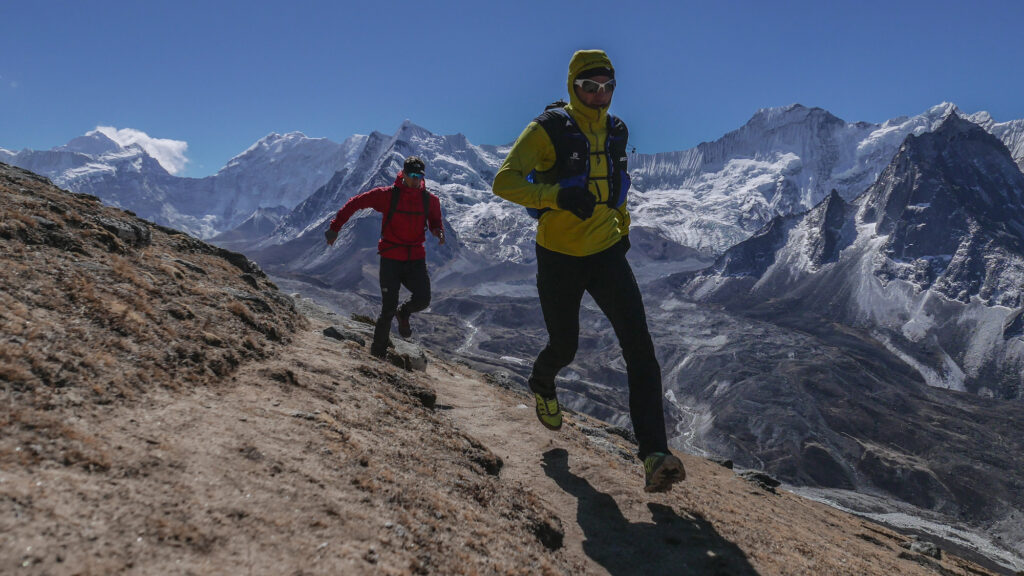
David and Ueli training in the Khumbu.
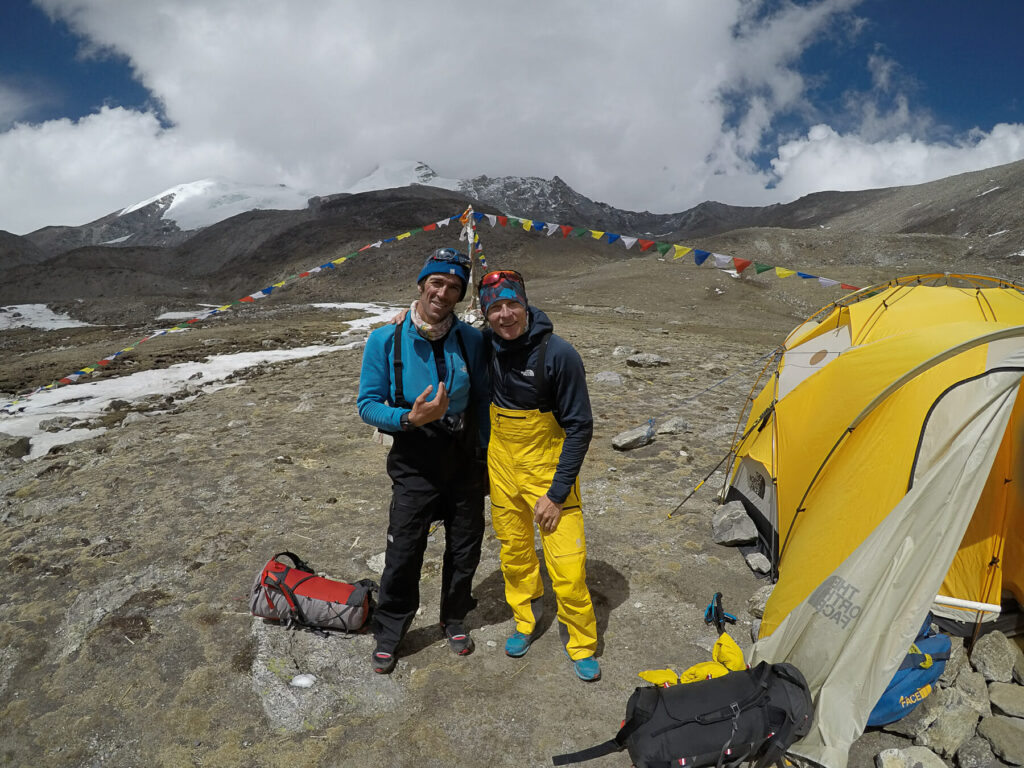
David and Herve back in BC after the climb.
After that training camp I had a six-week period back in Chamonix where I was able to get up to altitudes of around 4,000 meters two or three times a week to maintain my acclimatization. I’m certain that the Khumbu training camp with Ueli and Herve helped my performance on Shisha 2017. Read about it here.
For spring 2017 Ueli Steck had already committed to his Everest-Lhotse project so I asked Herve Barmasse to join me on Shishapangma and in him I found another perfect climbing partner. As with Ueli the previous year, our plan was to try to climb a new route. But, like in 2016 bad weather prevented us from being able to try this. So, we switched again to the idea of a single-day climb of the Girona Route. Conditions this year were more favorable and we managed to climb from the base of the face at 5,900 meters to just 5 meters below the summit in only 13 hours. We didn’t climb the last meters to the top because the risk of avalanche on the slope we had to cross was unacceptable.
Herve and I stashed a super-light bivy tent, a stove, some gas, and one sleeping bag at 7,400 meters on the way up. This allowed us to stop, rehydrate, and recover for a few hours on the way down before continuing our descent the following morning. In the days after our ascent I thought a lot about how I had felt in comparison to climbing the same route on the same mountain just 12 months before; I realized I had been able to carry a heavier load, move faster, break more trail, feel less exhausted, and recover more quickly than I had done the previous year. These were tangible, demonstrable, and incredibly important gains for me to have made as an alpinist.
It makes me happy to be able to look back over the past two years and not only feel stronger and fitter, but to be able to perceive and define subtle changes and clear improvements in my performance as an alpinist. It also fuels my motivation to continue on this path. Clearly it’s working so I’m excited to follow it further and see where it will take me. How much more can I achieve? How much harder can I train?
This article was originally published by David Goettler.

